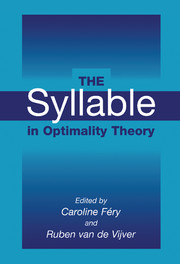Book contents
- Frontmatter
- Contents
- List of Contributors
- Preface
- The Syllable in Optimality Theory
- Part One INTRODUCTION
- Part Two SYLLABLE STRUCTURE AND PROSODIC STRUCTURE
- 2 Sympathy, Cumulativity, and the Duke-of-York Gambit
- 3 The Controversy over Geminates and Syllable Weight
- 4 The Syllable as a Unit of Prosodic Organization in Japanese
- 5 Prosodic Weight
- Part Three NONMORAIC SYLLABLES AND SYLLABLE EDGES
- Part Four SEGMENTS AND SYLLABLES
- Part Five HOW CONCRETE IS PHONOTACTICS?
- Author Index
- Languages Index
- Subject Index
3 - The Controversy over Geminates and Syllable Weight
Published online by Cambridge University Press: 03 July 2009
- Frontmatter
- Contents
- List of Contributors
- Preface
- The Syllable in Optimality Theory
- Part One INTRODUCTION
- Part Two SYLLABLE STRUCTURE AND PROSODIC STRUCTURE
- 2 Sympathy, Cumulativity, and the Duke-of-York Gambit
- 3 The Controversy over Geminates and Syllable Weight
- 4 The Syllable as a Unit of Prosodic Organization in Japanese
- 5 Prosodic Weight
- Part Three NONMORAIC SYLLABLES AND SYLLABLE EDGES
- Part Four SEGMENTS AND SYLLABLES
- Part Five HOW CONCRETE IS PHONOTACTICS?
- Author Index
- Languages Index
- Subject Index
Summary
Introduction
One of the major areas of research in syllable phonology is syllable weight; specifically, what types of syllables can function as heavy and how weight is represented. The moraic view of the syllable is a widely accepted approach for encoding syllable weight. Within this approach, it is generally agreed that a short vowel constitutes a single mora while a long vowel is bimoraic. With respect to consonants, however, there is a controversy over whether the difference between a single consonant and a geminate (long) consonant is one of inherent weight or of featural or other type of representation. On the one hand, Hayes (1989) posits the moraic theory of geminates whereby a geminate consonant is underlyingly moraic but a single consonant is not. On the other hand, Selkirk (1990) posits the two-root node theory of geminates whereby a geminate consonant is represented underlyingly as a consonant linked to two root nodes while a single consonant is linked to only one root node. In an earlier view of geminates, developed in Clements and Keyser (1983) and Hayes (1986), a geminate is represented as a consonant linked to two skeletal slots, but a nongeminate is represented as a consonant linked to a single skeletal slot. These three views are illustrated in (1)–(3), respectively. (The following abbreviations are used: UR = underlying representation, μ = mora, c = consonant, RN = root node, X = skeletal slot.)
- Type
- Chapter
- Information
- The Syllable in Optimality Theory , pp. 77 - 98Publisher: Cambridge University PressPrint publication year: 2003
- 3
- Cited by



